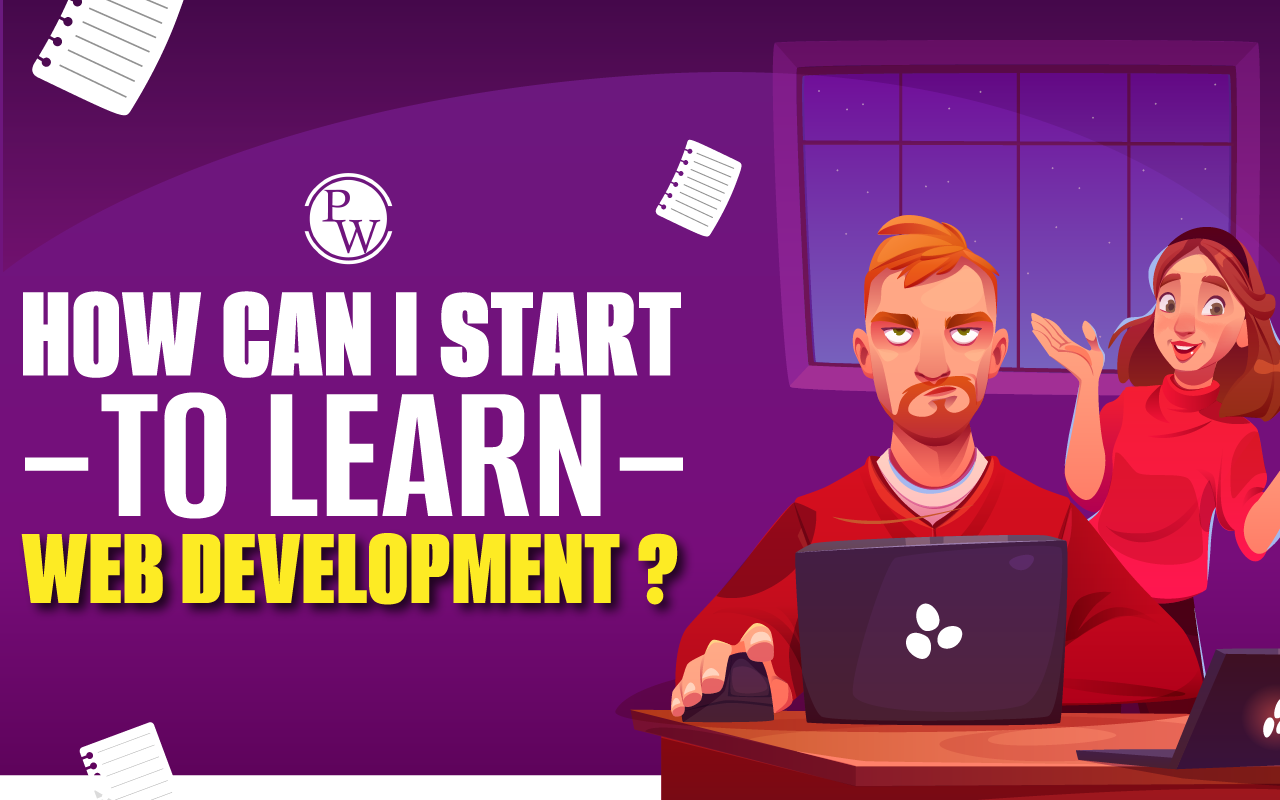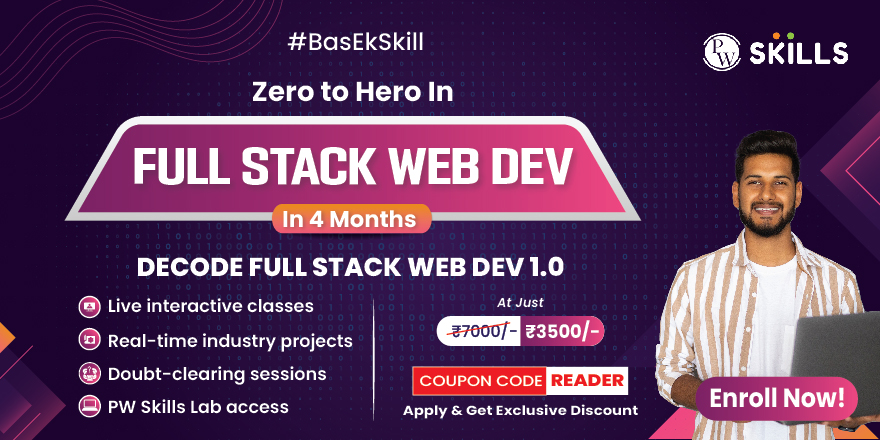Learn Web Development: In today’s digital age, the ability to create and maintain websites is a valuable skill. Whether you aspire to become a professional web developer or simply want to understand the intricacies of the online world, learning web development is a fantastic starting point.
Learning web development opens doors to a world of opportunities, allowing you to create, innovate, and contribute to the ever-expanding online ecosystem. If you’re looking to grow in your career or start a career as a web-developer, a Full-Stack Web Development course could be highly ideal for you! In this blog, we’ll talk about how to learn web development as a beginner.
What is Web Development?
Web development is divided mainly into two categories: front-end and back-end. Front-end work centres on shaping the user interface and experience, directly engaging users. Meanwhile, back-end development concentrates on the server-side of web apps, managing databases, server logic, and ensuring seamless communication between the server and the user’s device.
Essential Web Development Technologies
Embark on your journey by grasping the essence of fundamental web development technologies.
- HTML (Hypertext Markup Language): This is the bedrock of any webpage, giving it structure by defining elements like headings, paragraphs, images, and links. Consider HTML as the skeleton shaping your webpage.
- CSS (Cascading Style Sheets): While HTML structures your page, CSS contributes style and visual allure. It determines the appearance of HTML elements, specifying attributes such as colour, font, and layout. CSS transforms a basic HTML document into an aesthetically pleasing website.
- JavaScript: Often termed the “language of the web,” JavaScript is a dynamic scripting language. It empowers you to infuse interactivity into your web pages. Through JavaScript, you can alter webpage content, manage user input, and craft dynamic effects, enhancing the user experience.
Also Check: 10 Web Development and Web Design Facts That You Should Know
How to Learn Web Development in 8 Steps?
Here are 8 actionable steps to learn web development as a beginner:
Stage 1: HTML (Foundation of Web Development)
HTML is crucial in web development, forming the foundation. It acts as the framework for web pages, letting you organise content using elements like headings, paragraphs, links, and images. At this start, the focus is on comprehending HTML’s fundamental role in shaping a webpage’s structure.
Basic Structure and Syntax
Begin by acquainting yourself with the basic syntax of HTML. Construct a simple webpage by utilising elements like:
- <!DOCTYPE html>
- <html>
- <head>
- <body>
Dive into the world of tags, learning how to define headings, paragraphs, lists, and links.
Hands-on Exercises
Reinforce your understanding through hands-on exercises. Create a basic webpage, experimenting with various HTML elements. This practical approach solidifies your grasp of how different tags and attributes influence the layout and presentation of your content.
Stage 2: CSS (Styling Your Webpage)
CSS, or Cascading Style Sheets, takes the stage after mastering HTML. This language is dedicated to styling and layout on the web, providing control over colours, fonts, spacing, and overall design. It’s the artistic touch that transforms a webpage from a structural framework to an aesthetically pleasing interface.
Styling Elements, Fonts, Colors, and Layouts
Delve into CSS by learning how to style individual elements. Explore properties for fonts, colours, and different layout techniques. Understand selectors, the tools that allow you to pinpoint specific HTML elements for styling, giving your webpage a unique and personalised appearance.
Responsive Design Principles
As web users access content on an array of devices, responsive design becomes paramount. Master responsive design principles, employing techniques like media queries to ensure your webpage adapts seamlessly to different screen sizes. This ensures a consistent and enjoyable user experience.
Stage 3: JavaScript (Adding Interactivity)
JavaScript enters the scene to inject interactivity into your web development journey. As a versatile scripting language, JavaScript empowers you to create dynamic content, manipulate the Document Object Model (DOM), and respond to user interactions.
DOM Manipulation for Dynamic Content
Comprehend the Document Object Model and its interaction with JavaScript. Learn to dynamically manipulate HTML elements, enabling your webpage to respond to user actions. Dive into events and event listeners, the building blocks of interactivity in web development.
Introduction to Control Structures and Functions
Progress further into JavaScript by exploring essential programming structures like loops and conditionals. Grasp the concept of functions, allowing you to organise and reuse code efficiently. These programming fundamentals lay the groundwork for developing more complex web applications.
Stage 4: Bootstrap (Responsive Design Made Easy)
Bootstrap proves its strength as a potent front-end framework, simplifying the crafting of websites that are both responsive and mobile-friendly. Now, incorporate Bootstrap into your toolkit to elevate your development workflow.
Utilising Bootstrap’s Grid System and Components
Explore the nuances of Bootstrap’s grid system, which furnishes a responsive layout structure for your web pages. Acquaint yourself with Bootstrap components such as navigation bars, buttons, and forms, utilising them to enhance the visual allure and functionality of your projects.
Creating a Responsive and Mobile-Friendly Website
Implement your recently acquired Bootstrap expertise to construct a website that is entirely responsive. Understand how to employ the framework’s features to guarantee a seamless user experience across a spectrum of devices. This stage marks a significant stride toward becoming a well-rounded web developer.
Stage 5: PHP (Server-Side Scripting)
Moving from front-end to back-end development, PHP becomes pivotal. PHP, a server-side scripting language, is celebrated for crafting dynamic web pages, streamlining form processing, and overseeing user sessions.
Building Dynamic Web Pages with PHP
Acquaint yourself with the basics of PHP syntax and the embedding of PHP code within HTML. Explore the dynamic capabilities of PHP, including variable handling, form processing, and server-side scripting. Understand how PHP elevates the functionality of your web applications.
Basic Form Handling and Data Processing
A critical aspect of PHP is its prowess in handling forms and processing user input. Immerse yourself in form handling, validation, and data processing using PHP. Connect these server-side capabilities with your existing front-end knowledge to create interactive and dynamic web applications.
Stage 6: MySQL (Database Management)
The interplay between PHP and MySQL is crucial for constructing sturdy web applications. MySQL, a widely-used relational database management system, smoothly merges with PHP for efficient data handling and retrieval.
Creating, Querying, and Managing Databases
Grasp the fundamentals of relational databases and utilise MySQL adeptly for crafting, querying, and overseeing databases. Explore concepts like tables, relationships, and the SQL language to interact with your database. This knowledge forms the backbone of data-driven web applications.
Connecting PHP and MySQL for Dynamic Web Applications
Merge your PHP and MySQL skills to craft dynamic web applications. Investigate how PHP communicates with a MySQL database, allowing you to retrieve and manipulate data seamlessly. This integration opens up new possibilities for creating interactive, data-driven websites.
Stage 7: Advanced Technologies to Learn
As you progress, stay abreast of advanced technologies shaping the industry. Gain insights into server-side JavaScript with Node.js, the Express framework, and the growing importance of server-side development in modern web applications.
Understanding Git and Version Control
Version control is crucial for collaborative development. Learn the basics of Git, a distributed version control system. Comprehend how version control enhances collaboration, tracks changes, and facilitates the seamless integration of new features into your projects.
Stage 8: Frameworks, Libraries, API
Explore renowned web development frameworks such as React, Angular, and Vue.js. Understand their purposes, advantages, and use cases. Frameworks provide a structured approach to building web applications, significantly boosting your development efficiency.
Overview of Essential Libraries and Their Applications
Libraries like jQuery play a pivotal role in simplifying common tasks in web development. Gain an understanding of how libraries enhance your workflow, contributing to the creation of feature-rich and efficient web applications.
Understanding APIs and Integration
Application Programming Interfaces (APIs) are the glue connecting different software systems. Learn how to consume APIs in your web development projects, enabling you to integrate external services and data seamlessly into your applications.
Also check: Top 30 HTML Interview Questions and Answers in 2023
Introduction to Back-End Development
With a solid understanding of front-end technologies, it’s time to explore the back-end, where server-side logic and data management come into play.
1. Server-side vs. Client-side
Understanding the division between server-side and client-side operations is crucial. Client-side code (HTML, CSS, JavaScript) runs in the user’s browser, while server-side code handles tasks on the server, such as database interactions and business logic.
2. Common Back-End Languages
Various programming languages are used for back-end development.Node.js (JavaScript), Python, Ruby, and PHP stand out as favoured choices. Each language possesses distinct strengths, and the decision often hinges on personal preference and project requirements.
3. Basics of Server-Side Frameworks
Server-side frameworks, like Express.js (for Node.js), Django (for Python), and Ruby on Rails (for Ruby), give a structured environment for crafting web applications. They streamline development by supplying pre-built modules and tools for usual tasks.
Databases and Data Management
Understanding databases is crucial for handling and storing data in web applications.
1. Introduction to Databases
Databases are organised collections of data, and they play a vital role in web development. SQL databases like MySQL and NoSQL databases like MongoDB serve different purposes. SQL databases are relational, while NoSQL databases are non-relational and provide more flexibility in handling diverse data structures.
2. Basic Database Operations
Learning how to perform basic database operations, such as creating, reading, updating, and deleting data (CRUD operations), is fundamental. Database interactions are often facilitated by using a query language like SQL.
3. Connecting the Back End to a Database
The back end communicates with the database to retrieve or update data as needed. Understanding how to establish this connection and manage data flow is crucial for building robust and dynamic web applications.
Version Control and Collaboration
As you progress in your web development journey, collaboration becomes increasingly important. Version control and collaboration tools help manage code changes and facilitate teamwork.
1. Understanding Version Control (Git)
Git is a distributed version control system that tracks changes to your codebase. By creating branches, making commits, and merging changes, you can work on projects collaboratively without disrupting the main codebase.
2. Collaborating on Projects Using Platforms Like GitHub
GitHub is a web-based platform that hosts Git repositories. It facilitates collaboration by providing features like pull requests, issues, and project boards. Familiarising yourself with these tools will enhance your ability to work effectively with others.
3. Best Practices for Teamwork in Web Development
Effective teamwork involves adhering to best practices such as clear communication, consistent coding conventions, and regular code reviews. These practices contribute to a collaborative and efficient development process.
Building and Deploying Your Projects
After building your web application, the next step is to make it accessible to the world.
1. Hosting Options
Various platforms offer hosting services for web applications. GitHub Pages, Netlify, and Heroku are popular choices. Each platform has its strengths and caters to different needs, whether you’re hosting a static website or a dynamic web application.
2. Deploying a Simple Project
Transferring your code and assets to a server is the deployment process. Users can access it there. Knowing how to deploy a basic project is a valuable skill, showcasing your work to a wider audience.
3. Continuous Integration and Deployment (CI/CD)
CI/CD is a development practice that involves automating the testing and deployment processes. Tools like Jenkins, Travis CI, and GitHub Actions help ensure that your code is consistently tested and deployed, reducing the risk of errors in production.
Continuing Your Learning Journey
Web development is dynamic, and learning is ongoing. Keeping up with new technologies and industry trends is crucial for growth.
1. Resources for Ongoing Learning
Numerous online resources can aid your ongoing learning. Platforms like Codecademy, freeCodeCamp, and MDN Web Docs provide tutorials, exercises, and documentation to deepen your understanding of web development concepts.
2. Joining the Web Development Community
Engaging with the community enhances learning. Joining forums, like Stack Overflow, attending local meetups, and connecting on social media with fellow developers, provides valuable support, insights, and networking chances.
3. Staying Updated on Industry Trends
Staying current with industry trends is crucial. Web development continually evolves, introducing new frameworks, tools, and best practices. Keeping up through industry blogs, podcasts, and attending conferences ensures you’re informed about the latest technologies.
Setting Up Your Development Environment
Establishing your development environment is a priority. Before you code, choose a text editor or integrated development environment (IDE). Get acquainted with version control systems, such as Git.
1. Choosing a Text Editor or IDE
A text editor is a simple tool for coding, whereas an IDE offers a complete environment with debugging and project management features. Well-known options encompass Visual Studio Code, Sublime Text, Atom, and others. The key is to find a tool that suits your preferences and workflow.
2. Introduction to Version Control Systems
Version control is a crucial aspect of web development, allowing you to track changes to your code and collaborate seamlessly with others. Git, one of the most widely used version control systems, enables you to create snapshots of your project at different points in time. Platforms like GitHub provide a space for hosting your Git repositories and collaborating with other developers.
3. Setting Up a Basic Project Structure
Organising your project from the outset is a good practice. Define a clear project structure that includes directories for HTML, CSS, and JavaScript files. This not only makes your code more readable but also facilitates collaboration and future maintenance.
Responsive Web Design
As you progress, it’s essential to grasp the concept of responsive web design, ensuring that your websites look good and function well on various devices and screen sizes.
1. Importance of Responsive Design
With the proliferation of mobile devices, responsive design has become a standard practice. It involves creating flexible layouts and using media queries to adapt the design to different screen sizes. This ensures that users have a seamless experience regardless of the device they’re using.
2. Media Queries
Media queries are CSS techniques that enable you to apply different styles based on characteristics such as screen width, height, and resolution. By incorporating media queries into your stylesheets, you can create a responsive design that adapts to the user’s device.
3. Flexbox and Grid Layout
CSS Flexbox and Grid layout are powerful tools for creating flexible and responsive page layouts. These layout systems provide a more efficient and dynamic way to structure content, allowing for better control over the placement and alignment of elements on the page.
Also Check: Comprehensive Full Stack Developer Course Syllabus 2023
Final Thoughts
Embarking on your web development journey is an exciting and rewarding endeavour. By understanding the basics, setting up your development environment, learning essential technologies, and embracing both front-end and back-end development, you’re laying a strong foundation for your future endeavours. Remember, web development is not just about writing code; it’s about solving problems, creating meaningful experiences, and contributing to the vast and ever-growing digital ecosystem. So, buckle up, stay curious, and enjoy the journey ahead!
Become a job-ready full-stack web developer with the PW Skills Full-Stack Web Development Course! Learn from experienced instructors and gain hands-on experience with real-world projects. Sign up today and start your journey to a new career!
FAQs
Can I start learning web development without any prior coding experience?
Absolutely! Web development welcomes beginners. While having some coding experience can be beneficial, many resources cater specifically to those starting from scratch. Dive in with curiosity, dedication, and a willingness to learn.
What role does responsive design play, and why is it important?
Responsive design ensures that your websites adapt to various devices and screen sizes. It's vital because users access the internet through a multitude of devices. Learning responsive design guarantees your creations look polished and function seamlessly across smartphones, tablets, and desktops.
How do I choose between front-end, back-end, or full-stack development?
Consider your preferences and interests. Front-end developers focus on the user interface, back-end developers handle server-side logic, and full-stack developers navigate both. Explore each area, identify your strengths, and decide based on the aspects that resonate with you.
Is learning version control necessary, and what benefits does it offer?
Yes, learning version control, particularly Git, is essential. It enables you to track changes in your code, collaborate seamlessly with others, and revert to previous states if needed. Platforms like GitHub further facilitate collaboration and project management.
How do I stay updated on the latest web development trends?
Stay engaged with the web development community. Follow industry blogs, participate in forums, attend meetups, and explore social media platforms where developers share insights. This exposure ensures you're aware of emerging technologies and industry best practices.
What are the key considerations when choosing a back-end language?
Consider factors such as your project requirements, personal preferences, and the ecosystem around each language. Node.js (JavaScript), Python, Ruby, and PHP are popular choices. Each has its strengths, and the decision often depends on the nature of your project.
How does continuous integration and deployment (CI/CD) benefit web development?
CI/CD automates the testing and deployment processes, ensuring that your code is consistently tested and deployed. This practice minimises errors in production, enhances collaboration, and streamlines the development workflow, making it an integral part of modern web development practices





